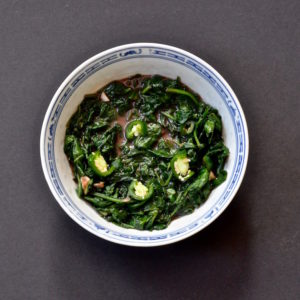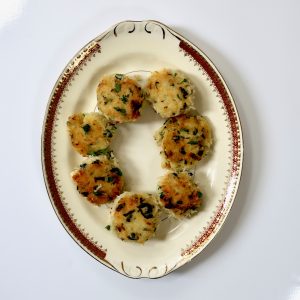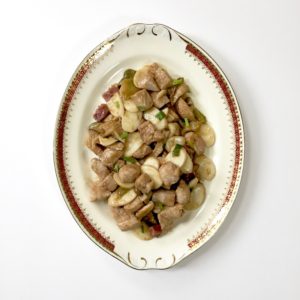Yogurt Flatbread
Back in November, before seeing Nigella Lawson at San Francisco’s Omnivore Books, I ate dinner at a nearby Chinese restaurant. The server asked if I wanted rice with my meal. Yes, I did. Astonished, he repeated the question. Yes, I repeated, I’d like rice with my meal.
The entree arrived with a tiny bowlful of rice alongside, precisely opposite of an authentic Chinese meal, which features lots of vegetables, a little animal protein or fish, and ample amounts of rice.
We all know why: carbs and their close buddy gluten, the latest culinary demons.
As a person who spends much of her time cooking, reading, and writing about food, both here and over at PopMatters.com, it’s in my best interest to follow the latest food trends. Thus I’ve watched carb-free, gluten-free eating attain religious fervor with a certain sector of society.
By a certain sector of society, I mean people with the time and money to fuss over their diet.The fact that I am writing about carbophobia places me squarely in this category. We’re the people who scrutinize food labels, worry over fossil-fuel calories, fret over farmed fish. We sniff disdainfully at Chilean tomatoes, open our wallets for pastured beef. We’re urging our cats to nibble kibble whose fish didn’t come from enslaved Thai fishermen.
Sometimes it’s hard to shut up about all the well-meaning good we’re doing. And man, are we ever insufferable.
What does this have to do with carbs and gluten? We’re also the people who want to live forever, or at least age very, very well. We’re doing yoga, we’re cutting down on booze, we’re doing cleanses. We want 50 to be the new 30.
The bad news is we’re all going to age and die. How and why we do so–living long, healthy lives or brief, miserable ones–is poorly understood. Genes, environment, and luck all factor into what basically remains an unknown.
Nevertheless, Americans inhabit a culture terrified of aging and death. And we’ll seize on anything promising to slow a process we’ve little control over. Like diet.
Hence entire groups of otherwise rational people are eliminating enormous classes of foods from their diets–dairy, legumes, wheat products, potatoes, alcohol, rice, sugar–and evangelically claiming all manner of benefit from it.
Are people truly benefiting? Is this the placebo effect? Does getting into the kitchen to cook the vegetables and expensive, pastured meats Paleo diets demand make people who once existed on take-out feel better? Hell if I know.
Here’s what I do know: you are an adult. Eat what you want. And let me eat what I want.
About a month ago I went to dinner with an acquaintance and a friend. Both have renounced gluten.The acquaintance, who ordered salad, scrutinized my meal in horror, behaving as if my burger and fries were a squirrel I’d beheaded live at table. The friend, always less inclined to judge, happily accepted my offer to share the fries. The conversation swirled around the horrors of pain medication before shifting to the perils of gluten, whose renunciation had led to all manner of vague improvements. Then it came, meaningfully. Had I considered giving up gluten? After all, it causes “inflammation.”
The idea that gluten consumption could impact Ehlers Danlos Syndrome, a genetic disorder, is akin to suggesting unleaded gasoline will help a car with a cracked engine block. That the average healthy person thinks he or she will will be spared from itchy skin, heartburn, or the exhaustion of daily living–i.e.–aging–by giving up carbohydrates verges on magical thinking. Coming from highly educated people, it’s troubling. Not to mention invasive and irritating.
Then there’s the question of a life without an oozing slice of Brie, a glass of champagne, a steaming baked potato dripping butter. In a life circumscribed by poor health, I will eat all things in moderation. This does not include fast food or sugary drinks, products we can all agree are terrible for you. Nor was I ever fond of fast food or soda anyway. But warm bread spread with butter? Cheese? Fava beans? French brandy? Oh hell yes.
None of the above applies to those with Celiac disease, who truly cannot ingest gluten. If Shauna James Ahern were coming to dine (I should be so lucky), she could rest assured of a meal prepared on all new plastic cutting boards (unable to trap the merest breadcrumb), prepared in a sandblasted, immaculate kitchen.
In that spirit, I bring you yogurt flatbread, a recipe that, with the mildest of tinkering, comes from Mollie Katzen’s Sunlight Café, a vegetarian cookbook proving the possibility of dietary choice without extremity.
Flatbread may be made without yogurt, but I prefer it with. You may also make these stovetop, but past efforts Chez IK led to smoky kitchens and blackened flour. I find the oven a better option.
Katzen’s recipe calls for nonstick spray, a product that has always creeped me out. Maybe that’s wrong, but I vastly prefer olive oil, which I pour into a ramekin and brush across the bread as necessary. Should you prefer butter, best to clarify it, or be prepared to reset your smoke detectors.
Yogurt flatbreads may be made plain, but I always add minced scallion or spring onion. Other additions include minced fresh garlic, shallot, fennel seed, paprika, salt, pepper, or, on the hotter end, red pepper flakes or cumin. Here, I added paprika, which gave a pretty pink color, a teaspoon of fennel seed, and some finely sliced spring onion.
Some words on cleanup: flour comes off countertops with a bench scraper. I’m also fond of white vinegar for cleanup where ammonia may be unwelcome–for example, near food. Spray your counter liberally with white vinegar, scrape with bench scraper, wipe clean with old rags or paper towels. Bye bye, gritty, floury mess.
While we’re chatting practicalities: I keep one pastry brush for olive oil and another for butter.
I part ways from Katzen’s recipe in method. Her dough comes together in one bowl. I prefer dumping mine on the counter and kneading before transferring the dough to a clean bowl for the rise. Yes, more dishwashing, but more confidence in the kneading. Thus, more confidence in the final, wonderful result. Yep, you’re washing two bowls instead of one. Surely you can cope with that.
There is nothing hard about this recipe, but you’ll want to read it through before starting–trust me, I didn’t at first, and it was quite the floury experience, especially given attempts at photography. Don’t be me.
About yeast: store yeast in the fridge or freezer, where it should keep for about a year. If you yeast has been sitting in the cupboard for five years, toss it and buy a fresh package or jar.
Yogurt Flatbread
yield: 8 flatbreads
adapted from Mollie Katzen’s Sunlight Café
preparation time: approximately 2 hours, most of which is bread-rising time
1/4 cup warm water
1 1/4 teaspoons yeast
pinch sugar
1 cup plain yogurt
1 tablespoon olive oil, plus separate 1/3 cup for brushing freshly baked breads
3/4 teaspoon salt
2 cups+2 tablespoons all purpose flour, plus more for counter/rolling pin
cornmeal or flour for baking trays
optional additions used in this recipe:
some minced scallion or spring onion (I used spring onion)
1 teaspoon ground fennel seed
1 teaspoon mild paprika
coarse salt, sprinked on freshly baked breads
Prep note: In addition to the large bowl needed for mixing the dough, you’ll need a second medium/large bowl to hold the dough as it rises. This second bowl needs oiling with olive oil, and a clean dishtowel to keep it from catching a chill.
Proof the yeast by spooning it into a large mixing bowl and adding 1/4 cup warm water. Old recipes call for “blood heat”. Don’t make the water hot, or it will kill the yeast. Add the pinch of sugar. This it to give the yeast something to snack on. Let the yeast proof about 5 minutes. You’ll notice it “bloom” and start to smell nicely, well, yeasty.
If you plan to add the optional spring onion, scallion, fennel seed, paprika, whatever, stir these ingredients into the yogurt:

Add the yogurt (a spatula is helpful here) the tablespoon of olive oil, and salt to the yeast. Whisk until blended.
Now add a cup of flour and stir to blend with a wooden spoon.
Okay, now I want those of you with limited baking experience to breathe deeply. Be brave. Make space someplace you can knead: a countertop, a table, where ever. Make sure this space is clean–wipe down with your white vinegar. Make a little pile of flour. Flour your hands. Dump the dough, a shaggy mess, onto what I’m calling your countertop:

A mess, right? Don’t worry about a thing, because like Bob Marley said, every little thing is gonna be all right. Just add the remainder of the flour to this mess, gather it in with your hands, and gently knead.
The yogurt means this dough will be sticky. Resist the urge to add bushels of flour. Remember the yield is only 8 breads. You just want the dough to integrate. Like this:

Place in your second oiled bowl. Oil the dough, too, just lightly. Cover with a clean dishtowel and tuck in a warm spot, like near your oven. Leave for 90 minutes. Dough should double in bulk.

Now, in the spirit of total honesty that has characterized this blog to date and made exactly 13 of you love me enough to become regular readers (never mind that some of you loved me before: I thank you anyway, wholeheartedly), I confess my dough did not double in bulk this time around. I am not a timid bread baker, and share this because I knew my yeast was alive and otherwise doing its yeast thing, and decided to go ahead and bake the flatbreads, which were wonderful. So I am sharing my knowledge here.
Why didn’t the dough double in bulk?
My house was chilly, that’s why. I’d turned the thermostat down, the weather was damply chill, with rain forecast, and the dough was having none of it. When I realized this, 90 minutes in, I preheated the oven to 450 F, our next step in the recipe, and parked the bowl atop the stove for an extra 10 minutes.
So, how do you know if your yeast is alive?
Your bread will be springy. A finger pressed into the dough will leave an indentation that will slowly spring back. The dough will feel alive, like it’s coming back at you. That yeast smell I mentioned earlier? You’ll still smell it. Cooking is about all your senses. Use them. It’s also about confidence. Go ahead. Make your flatbread.
Okay, so preheat the oven to 450 F.
Have at least one baking tray ready. Sprinkle it with cornmeal (best) or flour.

Have a small ramekin of olive oil and a pastry brush ready. If you are sprinkling your breads with salt, have that ready, too.
Lightly flour your work surface and a rolling pin.
Plop the dough on the countertop. Flour your hands again. Punch down the dough. Cut with a knife or scissors into eight equally-sized lumps. Dough will be sticky and may resist you. Avoid overhandling.

Shape each piece into a ball. They may fight back a little. That’s okay. Allow them to rest a few minutes.

Now take your floured rolling pin and gently roll a ball out into round, or something approximating one.

Lay it gently on the baking sheet. You may be able to get two or three dough rounds on one baking sheet, depending on the size of the sheet. Do whatever works without crowding the sheet.

Place these into the oven and bake five minutes per side. I flip the breads with tongs.
After ten minutes, remove the baking sheet and paint each side of the flatbread with olive oil (or butter). Salt lightly, if you wish. Try not to eat them all by yourself in the kitchen.

Flatbreads are best eaten fresh. But if you wrap them well, leftovers can be reheated in a low oven or microwave. They also freeze well.
We ate these with lamb, more yogurt (me), and crisp Romaine lettuce.





